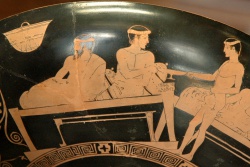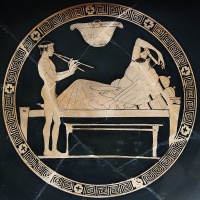Ancient Greece: Difference between revisions
| Line 11: | Line 11: | ||
[[Pederasty]] was the idealized form of an age-structured homoeroticism that had other, less idealized manifestations, such as prostitution or the sexual use of slave boys. Paying free youths for sex was prohibited. Free youths who did sell their favors were ridiculed, and later in life might be prohibited from performing certain official functions. | [[Pederasty]] was the idealized form of an age-structured homoeroticism that had other, less idealized manifestations, such as prostitution or the sexual use of slave boys. Paying free youths for sex was prohibited. Free youths who did sell their favors were ridiculed, and later in life might be prohibited from performing certain official functions. | ||
== Sexual Practices == | == Sexual Practices == | ||
Revision as of 11:31, 25 September 2014

Boylove in Ancient Greece was quite common between older men (lover Erastes) and boys (beloved eromenos), and was not unusual or frowned upon. The most common place where men would go to meet boys was the palaestra (the Greek word for their version of a gymnasium) where older men watched the young boys exercising. This being the case, only leisured aristocrats with time on their hands probably really engaged in homosexual affairs. Only when men carried on a relationship with a boy who entered adulthood was the man scorned.
Courtship
Once a man had selected a boy from the palaestra, the next step would be to take him to the andreion, a sort of men's club or meeting hall. The youth received gifts, and the philetor along with the friends went away with him for two months into the countryside, where they hunted and feasted. At this end of this time, the philetor presented the youth with three contractually required gifts: military attire, an ox, and a drinking cup. Other costly gifts followed (see Trochus). In Crete, in order for the suitor to carry out the ritual abduction, the father had to approve him as worthy of the honor. However, according to Aeschines, Athenian fathers would pray that their sons would be handsome and attractive, with the full knowledge that they would then attract the attention of men and "be the objects of fights because of erotic passions."
Copulation with the pederast was a choice the boy could make; it was not required. Pederast/Catamite relationships were not monogamous; both boys and men were free to engage in as many of these such relationships as they chose. Typically, after their sexual relationship had ended and the young man had married, the older man and his protégé would remain on close terms throughout their life.
Social Aspects
Pederasty was the idealized form of an age-structured homoeroticism that had other, less idealized manifestations, such as prostitution or the sexual use of slave boys. Paying free youths for sex was prohibited. Free youths who did sell their favors were ridiculed, and later in life might be prohibited from performing certain official functions.
Sexual Practices

Vase paintings and an obsession with the beloved's appealing thighs in poetry indicate that when the pederastic couple engaged in sex acts, the preferred form was intercrural. To preserve his dignity and honor, the erômenos limits the man who desires him to penetration between closed thighs.
Anal sex may be depicted, but far more rarely. The evidence is not explicit and is open to interpretation. Some vase paintings, which Percy considers a fourth type of pederastic scene in addition to Beazley's three, show the erastês seated with an erection and the erômenos either approaching or climbing into his lap. The composition of these scenes is the same as that for depictions of women mounting men who are seated and aroused for intercourse. As a cultural norm considered apart from personal preference, anal penetration was most often seen as dishonorable to the one penetrated, or shameful. Oral sex is likewise not depicted, or is indicated only indirectly; anal or oral penetration seems to have been reserved for prostitutes or slaves.
See also
External links
References
- Stephen Batchelor: The Ancient Greeks for Dummies — John Wiley & Sons, 2008. — ISBN 978-0-470-98787-2